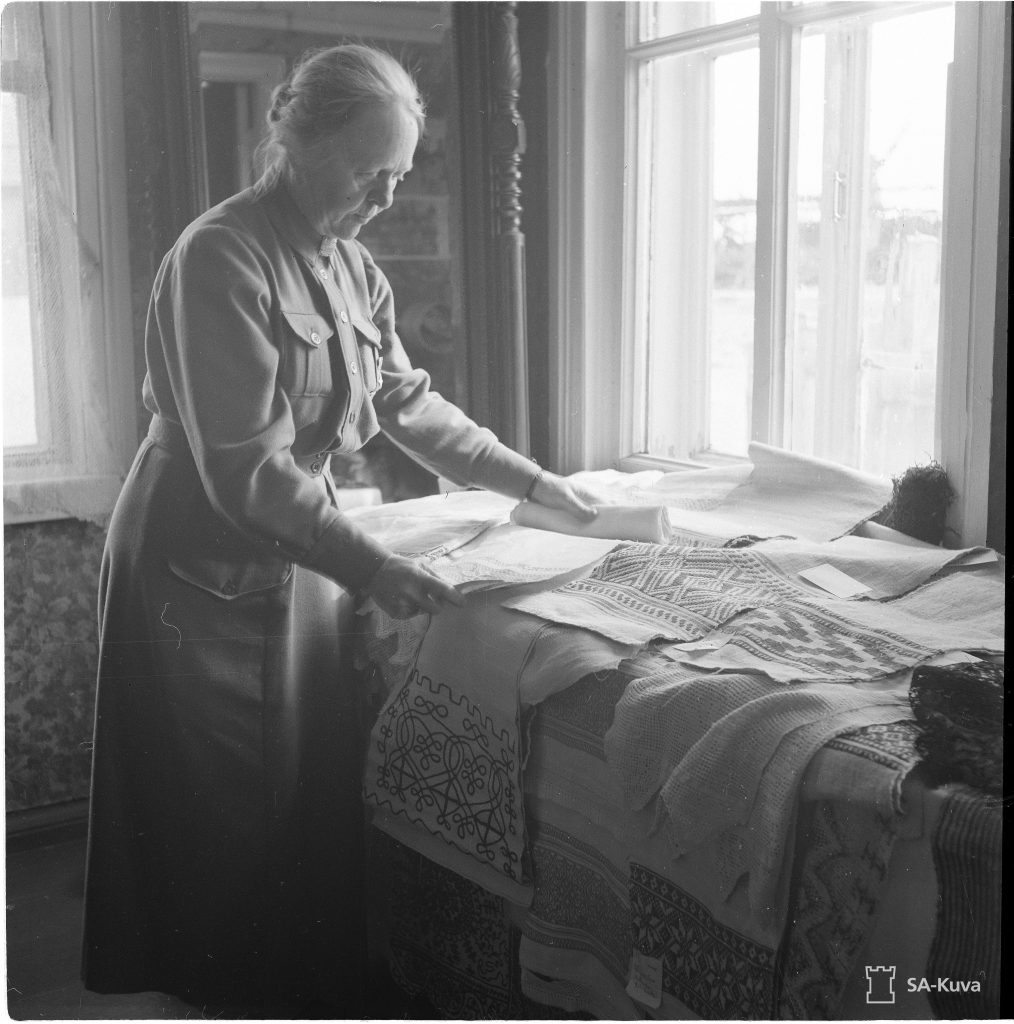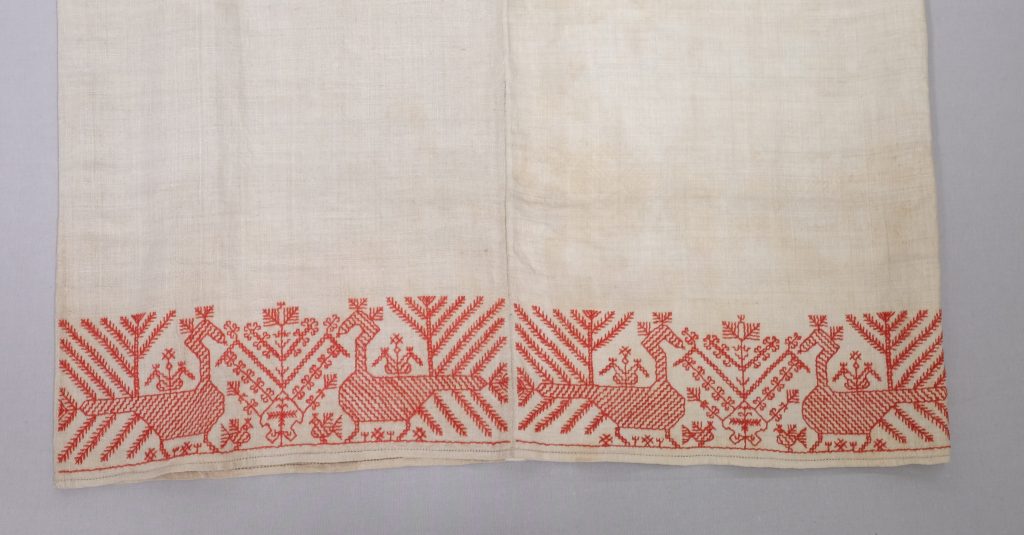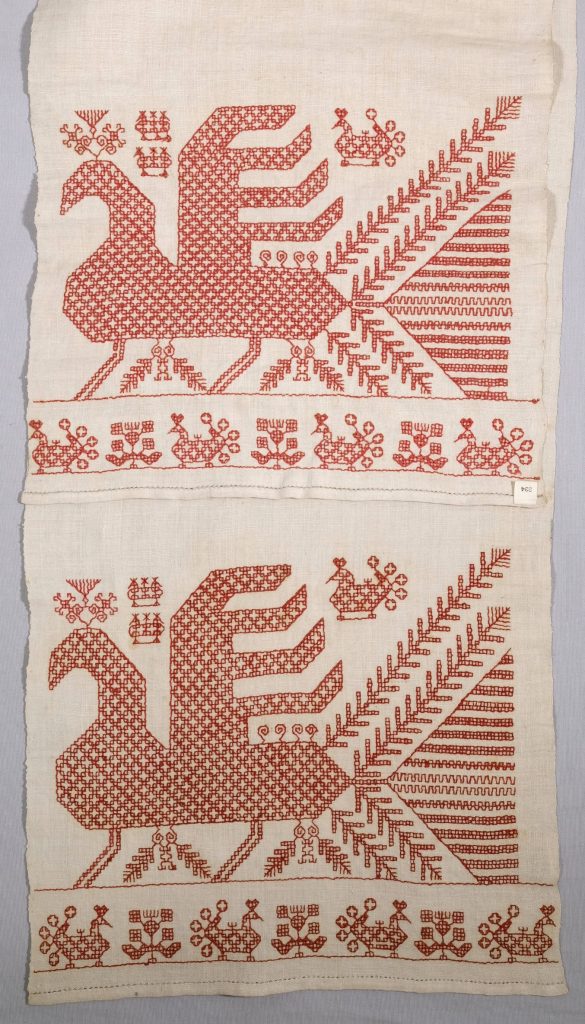Our object of the month in February is an embroidered piece of cloth from Eastern Karelia, brought over by Aino Ollila during the Continuation War between the Soviet Union and Finland (1941–44). Ollila was a craft teacher and member of the auxiliary paramilitary Lotta Svärd organisation for women, and this piece of cloth is part of a collection of Karelian embroidery samples. The object is a white linen cloth embroidered with a stylised bird in red thread and a folded and sewn hem at the bottom. On the right is the selvedge, the bound side edge of the fabric. The top and left edges have been cut with scissors. The embroidery threads have snapped at the left edge, which indicates that the embroidery was originally wider and the piece has been part of a larger cloth, possibly a rushnyk (in Finnish käspaikka), a long, narrow cloth common in the Karelian and Eastern Orthodox cultures. Although that is just about all we know about this particular piece, it can still tell us quite a bit about Finnish history.

The mythical Karelia
After Finland’s annexation by Russia in 1809, areas previously located across the border in Karelia became accessible to Finns. Inspired by the ideology of kindred nations and Karelianism, Finns headed east to seek the origins of their national identity, the foundation of what being Finnish was. One of these cornerstones of Finnish identity defined in the 1830s was the Kalevala epic compiled by Elias Lönnrot. In the late 19th century, Karelia became an inexhaustible source of inspiration for Fennoman artists whose works provided some of the most visible resistance to the unification efforts of the Russian Empire. Few people actually visited Karelia, however, and those who did may have been disappointed. Karelia was more a state of mind that attracted people as the mythic birthplace of ancient Finns. After Finland declared its independence in 1917, Karelia continued to attract visitors – not only artists and researchers, but also activists, politicians and soldiers. Eventually, even the Finnish government crossed the existing border in 1941, conquering Eastern Karelia.

Craft teachers in a war zone
In the wake of the Finnish offensive, a cleaning crew arrived, including craft teacher Maija Stenij (1887–1944), a member of the Lotta Svärd organisation. During the recession of the 1930s, she had worked as an inspector for the Ministry of Social Affairs and organised workshops as part of the social welfare and employment activities of the time. She was reportedly also the person who took the initiative to establish workshops for the civilian population of Eastern Karelia to manufacture and repair textiles and footwear and organise handicraft courses. In addition, Stenij began collecting traditional local textiles with the aim of establishing a museum for the handicraft industry in Eastern Karelia. Such projects received funding from the military administration in Eastern Karelia.

Another woman working with the Eastern Karelian textile heritage together with Stenij was Aino Ollila (1900–1972), who wrote articles on the topic for Kotiliesi magazine. The collaboration between Ollila and Stenij led to the publication in 1946 of the book Karjalan kirjonta (‘Karelian embroidery’), which Stenij never got to witness, however, as she succumbed to a sudden illness in summer 1944.

Collecting cultural heritage in the midst of destruction and devastation
Several collaboration partners participated in collecting and depositing the material and immaterial cultural heritage of Finno-Ugrian peoples in the war zone (Pimiä, 2004, 1). The goal was to demonstrate that Eastern Karelia belonged to Finland. One of the individuals involved in this work was Helmi Helminen, a University of Helsinki history graduate from 1928, who arrived in Reboly (Repola) in 1941 together with the cleaning crew as an expert on ancient objects and collected such items for the National Museum of Finland. She described the situation in the midst of the destruction and chaos of war as follows:
“In the camp grounds, the contents of a shed had been stacked behind it. All sorts of rags were there, soaking wet and partly frozen. The best items had already been taken, too many people had had the chance to go over the contents and ‘take mementoes’. (…) It was difficult to find anything for the museum from this village ravaged by fire and war. I observed nothing I couldn’t get elsewhere. A few woven bands, a spindle stick and distaff, a patchwork rya, a few sickles and clay pots, a linen brush, a ball of coarse flax yarn, net-making tools, a spinning wheel, a wooden spoon and a small rag doll, a kugla, that was it. The cleaning crews and Lotta Svärd members working in the village had carefully collected all rushnyks, caps and decorative blouses. I recovered a piece of an embroidered shirt hem from where their rucksacks were.”

Karelian additions to the craft science collection
After the war, objects collected for the government from Eastern Karelia had to be returned to the Soviet Union, but some craft collections acquired by private individuals remained in Finland. Aino Ollila, Karelian-born herself, had an extensive career as a teacher at the Helsinki Craft School. This may be why samples of the Karelian crafts she had collected ended up in the museum of the Helsinki institute for textile teacher education, which later became the Helsinki University Museum’s craft science collection. Today, the collection includes a total of 102 embroidery and textile samples donated by her. The majority of the samples are said to have been brought over from Olonets [Aunus] during the war. In addition, the craft science collection includes 37 similar objects, of which no details are available. They are connected to Karelia only by their names, such as ‘käspaikan pää’ (the embroidered end of a cloth) or ‘rätsinän helma’ (the embroidered hem of a woman’s blouse) and by the features they share with the items donated by Ollila. If their origins and stories have been known at some point, this knowledge has unfortunately been lost. In addition to the samples of Karelian textiles, the Helsinki University Museum collections contain a dozen whole rushnyks, that is to say, traditional cloths that are part of the Karelian and Eastern Orthodox cultures, among others. In their most ordinary form, they were used as towels, whereas at their most sacred they were ritual objects with an important role in family celebrations and healing rituals.

In the object of the month, the bird motif has been embroidered in red on a white cloth using a reversible double running stitch, which means the stitch is identical on both sides of the fabric. All these features are old and typical of the embroidery used by Finno-Ugrian peoples in Karelia. For them, embroidery was not simply about decoration; it was of symbolic significance, which is why the techniques and motifs remained long unchanged. The motifs were either geometric or, as in the case of the bird, stylised. At present, the bird motif is often known in Finland as ‘kukkilintu’ and associated with joy and happiness. It was not until the 1930s that embroidery and all rituals of manufacturing and using textiles lost their significance in the Soviet Union. Perhaps the Finnish Lotta Svärd volunteers, cleaners and researchers dug through the piles of rags in Eastern Karelia not for spoils of war, but for pieces of a lost world.

Helena Hämäläinen, Curator
Translation: University of Helsinki Language Services.
This object will be included in the museum’s new core exhibition, to be opened in the University of Helsinki Main Building in autumn 2023.
Sources:
Helminen, H. (2008). Matkapäiväkirja: Museoesineiden keruumatka Repolassa 6.10.-18.11.1941 Teoksessa Kulttuurien museo, Lehtinen, I., Holmström, E., & Hopeala, A. (2008). Rajantakaista Karjalaa. Kulttuurien museo. Kulttuurien museon näyttelyjulkaisu, 84-123.
Hämäläinen, H. 2016. Kolme näkökulmaa Helsingin yliopistomuseon käsityötieteen kokoelmaan. Käsityötieteen pro gradu -tutkielma. Käsityönopettajan koulutus. Opettajankoulutuslaitos. Helsingin yliopisto. Saatavilla sähköisenä https://ethesis.helsinki.fi/repository/handle/123456789/8680
Lausala, Talvikki 2007. Aunuksen aika. Teoksessa Sirkka-Liisa Uutela (toim.) Taitoa Tarvitaan. Kutsumukselle uskollinen elämäntyö. Käsityöneuvos Tyyne-Kerttu Virkki 1907–2000. Helsinki: Tyyne-Kerttu Virkki -säätiö. 23–26.
Koskinen, S. 2019. Käspaikkojen kauneutta. Suomen käsityönmuseon blogi. https://www.craftmuseum.fi/blogit/suomen-kasityon-museon-blogi/kaspaikkojen-kauneutta Katsottu 26.1.2023.
Pelgonen, I. 2022. Ukrainassa käspaikka saattelee ihmistä kehdosta hautaan, ja sen kirjonta on tulvillaan kiehtovaa symboliikkaa. Aamun koitto – orto https://aamunkoitto.fi/arki-ihmiset/ukrainassa-kaspaikka-saattelee-ihmista-kehdosta-hautaan-ja-sen-kirjonta-tulvillaan?fbclid=IwAR0vkrETk9d3rz1OtKBSFVrl962snqBjz-DH5mGKbHR-w46jJN2A8k0vv84
Pimiä, Tenho 2007. Sotasaalista Itä-Karjalasta. Suomalaistutkijat miehitetyillä alueilla 1941–1944. Helsinki: Ajatus.
Survo, V. (2008). Kirjottua historiaa. Teoksessa Kulttuurien museo, Lehtinen, I., Holmström, E., & Hopeala, A. (2008). Rajantakaista Karjalaa. Kulttuurien museo. Kulttuurien museon näyttelyjulkaisu, 157-163.
Tepora, T. 2014. Heimoveljiä, valkobandiitteja ja punikin perkeleitä – Valkoisen ja punaisen Suur-Suomen aate- ja tunnehistoriaa ennen toista maailmansotaa. Teoksessa Sari Näre & Jenni Kirves (toim.). Luvattu maa, Suur-Suomen unelma ja unohdus. Helsinki, Johnny Kniga.
